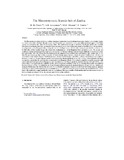| dc.contributor.author | De Waele, B. | |
| dc.contributor.author | Kampunzu, A.B. | |
| dc.contributor.author | Mapani, B.S.E. | |
| dc.contributor.author | Tembo, F. | |
| dc.date.accessioned | 2009-10-28T06:46:08Z | |
| dc.date.available | 2009-10-28T06:46:08Z | |
| dc.date.issued | 2006 | |
| dc.identifier.citation | De Waele, B. et al (2006) The Mesoproterozoic Irumide belt of Zambia, Journal of African Earth Sciences, Vol. 46, pp. 36–70 | en_US |
| dc.identifier.issn | 1464-343X | |
| dc.identifier.uri | http://hdl.handle.net/10311/398 | |
| dc.description.abstract | The Mesoproterozoic Irumide belt is a northeast-trending structural province stretching from central Zambia to the Zambia–Tanzania
border and northern Malawi. Mesoproterozoic and Neoproterozoic transcurrent shear zones within reactivated parts of the Palaeoproterozoic
Ubendian belt define its northeastern limit. The northwestern margin is defined by the largely undeformed basement
lithologies of the Bangweulu block. An intensely folded and sheared zone at the southeastern margin of the Mporokoso Group sedimentary
depocentre on the Bangweulu block, interpreted to have developed above a thrust at the basement-cover interface, indicates that
far-field effects of the Irumide Orogen also affected the southeastern part of the Bangweulu block sedimentary cover. To the west and
southwest, Irumide and basement lithologies were reworked by the Damara–Lufilian–Zambezi Orogen within the Neoproterozoic Zambezi
and Lufilian belts. The Choma–Kalomo block, previously regarded as the southwesterly continuation of the Irumide belt, is a distinct
Mesoproterozoic province, while a succession of structurally juxtaposed tectonic terranes in eastern Zambia record a deformation
event related to the Irumide Orogen. The lithological units identified in the Irumide belt include: (1) limited Neoarchaean rocks emplaced
between 2.73 and 2.61 Ga and representing the oldest rocks in the Bangweulu block; (2) ca. 2.05–1.85 Ga volcano-plutonic complexes
and gneisses representing the most important components in the Bangweulu block; (3) an extensive quartzite–metapelite succession with
minor carbonate forming the Muva Supergroup, and deposited at ca. 1.85 Ga; (4) granitoids emplaced between 1.65 and 1.55 Ga; (5) a
minor suite of anorogenic plutons (nepheline syenite and biotite granite) restricted to the far northeastern Irumide belt and emplaced
between 1.36 and 1.33 Ga; (6) voluminous syn- to post-kinematic Irumide granitoids emplaced between 1.05 and 0.95 Ga. Crustal shortening
and thickening in the Irumide belt are shown by northwestward-directed thrusts and related folds and metamorphic parageneses
recording a clockwise medium-pressure/medium-temperature P–T–t path. Metamorphic grades range from greenschist facies in the foreland
to the northwest to upper amphibolite facies in the southeast, with local granulites. Peak metamorphism is diachronous across the
belt and bracketed between 1.05 in the southeast and 1.02 Ga in the northwest. | en_US |
| dc.language.iso | en | en_US |
| dc.publisher | Elsevier www.elsevier.com/locate/jafrearsci | en_US |
| dc.subject | Irumide belt | en_US |
| dc.subject | Palaeoproterozoic Muva Supergroup | en_US |
| dc.subject | Mesoproterozoic granitoids | en_US |
| dc.subject | Bangweulu block | en_US |
| dc.title | The Mesoproterozoic Irumide belt of Zambia | en_US |
| dc.type | Published Article | en_US |

